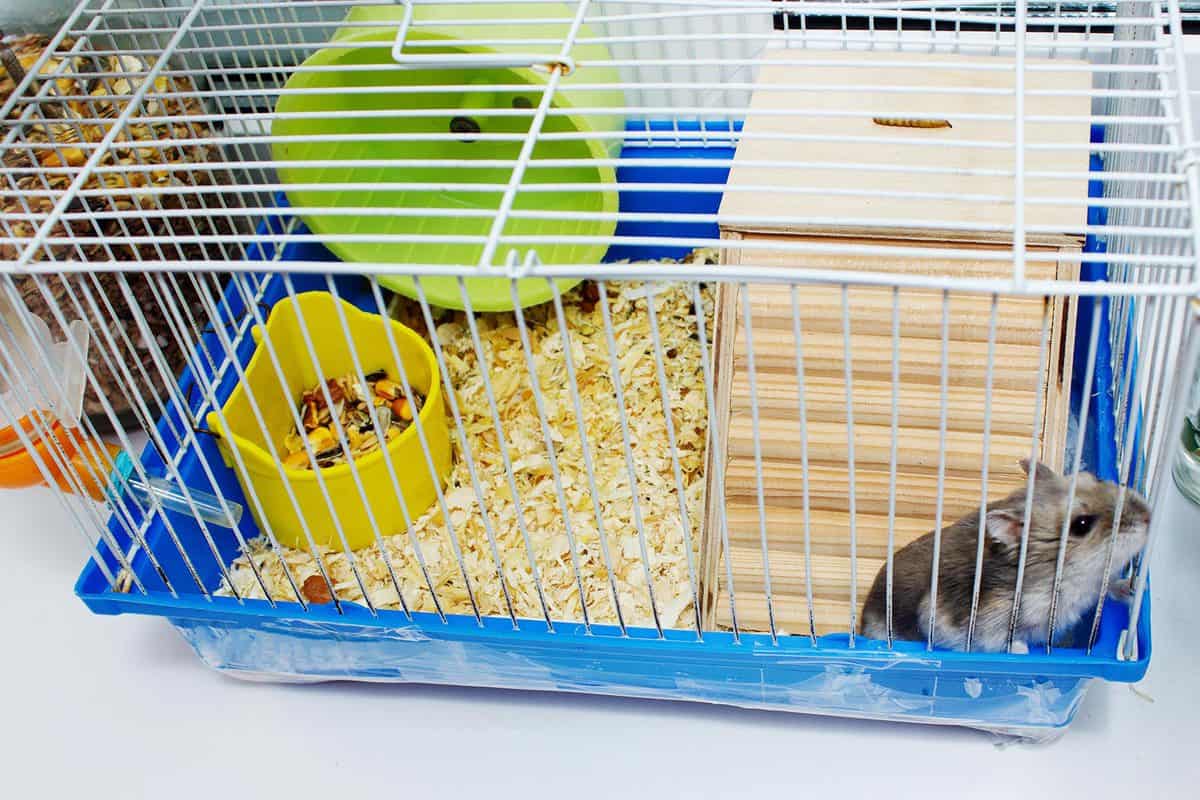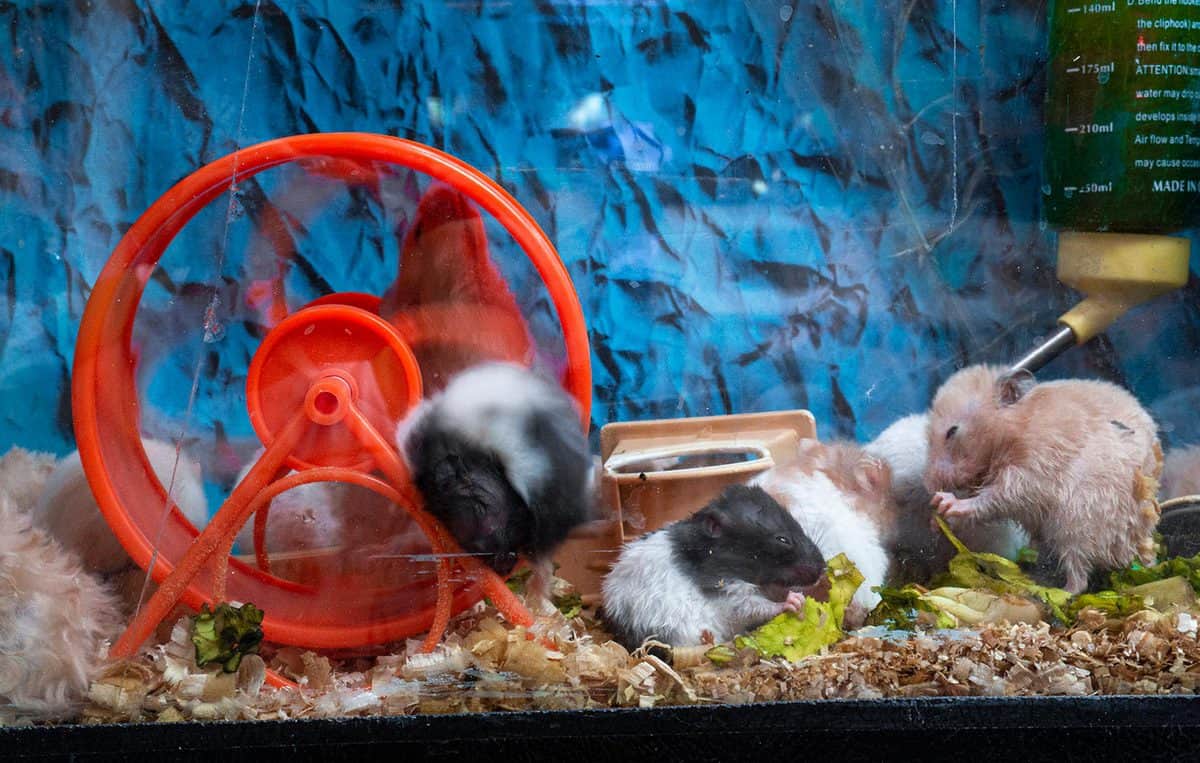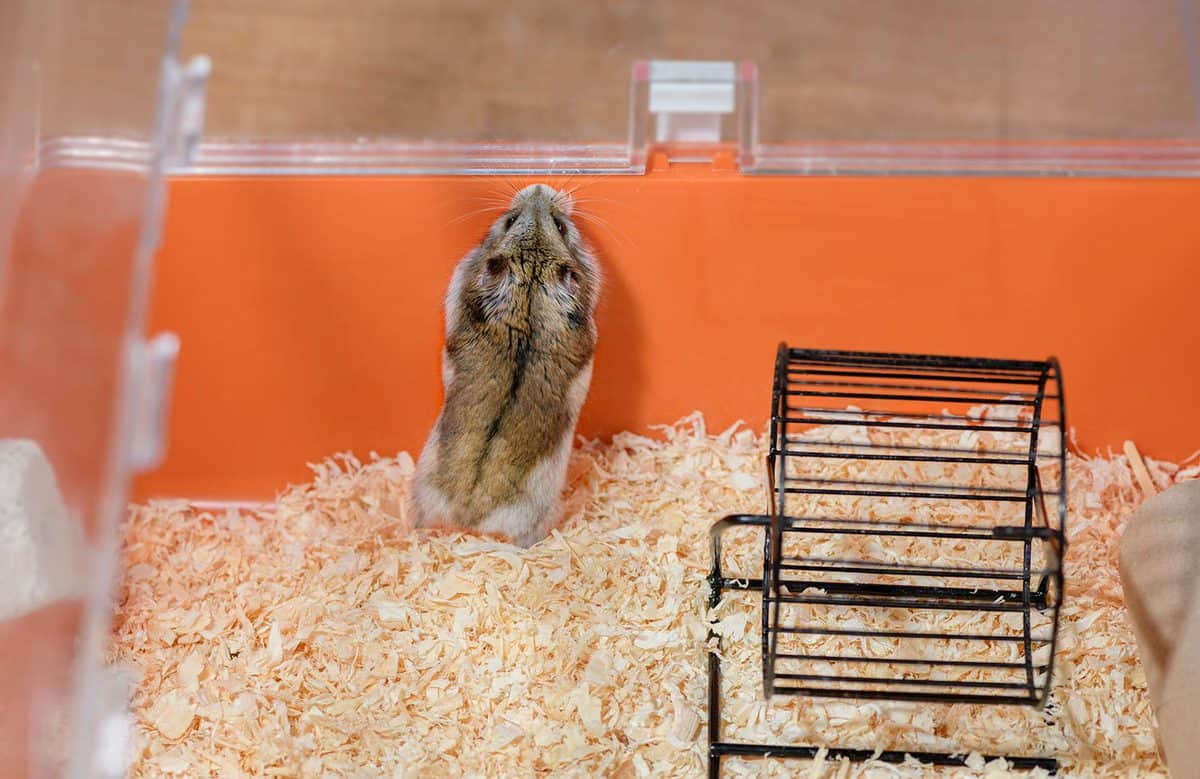 How often should you be cleaning out your hamster's cage? Sometimes it may be hard to tell whether or not the cage needs cleaning, and you may find yourself putting off the task. We've set out to find the correct cleaning frequency recommended by hamster experts, and we have some answers.
How often should you be cleaning out your hamster's cage? Sometimes it may be hard to tell whether or not the cage needs cleaning, and you may find yourself putting off the task. We've set out to find the correct cleaning frequency recommended by hamster experts, and we have some answers.
You should fully clean your hamster's cage every week or so. With an exceptionally large cage, you can get longer intervals between cleaning. Ideally, you should be spot checking your hamster’s cage on a daily basis. This involves removing wet and soiled litter from the cage, as well as any uneaten fresh food, and replacing the soiled litter with fresh litter.
Cleaning a hamster's cage is a bit of a process, and you have to be thorough and regular with your cleaning; cleaning the cage too often or not often enough can cause stress or illness in your hamster. Keep reading to see what your cleaning routine should include - at which frequency.
Daily cleaning of a hamster's cage
Let's go over the cleaning routine every hamster owner needs to stick to. First, this is what you need to do on a daily basis -
- Inspect the cage.
- Remove visible debris such as chewed toys and leftover food chunks.
- Get wet and dirty bedding out and replace with fresh dry bedding. If your hamster uses a small litterbox, clean the litter daily, as you would with a cat's litter box.
This shouldn't take more than a couple of minutes and will keep the cage as odor-free as possible.
And then there's the weekly cleaning process.
Weekly cleaning of a hamster's cage

Once a week, you should get your hamster out of the cage for a more thorough cleaning. Here's how to go about it, step by step.
Remove the hamster
Make sure your hamster is completely removed from the cage before cleaning. Your hamster friend can be placed in an exercise ball for some fun while you’re cleaning, or even an alternate cage or bin.
Remove everything from the cage
Everything from the cage needs to be removed: old bedding, toys, exercise stations, the food bowl, and the water bottle. The old bedding should be thrown away, preferably in a tied up bag to avoid odor. Any leftover food or water should be dumped out.
Wash Items
Everything that was inside the cage needs to be washed thoroughly to get rid of any potential bacteria. Inside and out these items need to be washed out, and they must be properly rinsed and thoroughly dried before being placed back inside the cage. If you have an intricate tubing system for your hamster to run around in - kudos to you! - consider putting them apart and cleaning them too, as may be necessary. Once a month may be too often for these, as it can be a hassle to pull them apart and put them together again.
Clean the cage itself
Even though the bedding and litter were covering most of the cage, the entire cage still needs to be cleaned. If there is bedding or litter stuck to the floor or bars of the cage, you can either scrape them off or soak in warm soapy water. The cage bars, if applicable, must also be wiped down.
The cage can either be wiped down with a dry cloth to dry faster or can be set outside to be dried by the sun.
Put everything back
Ensure that every item that belongs in the cage is dry before putting it back inside. The bedding should be fresh, as well as the litter and any food and water. Only after everything is set up inside should your hamster friend be placed back inside.
There are other factors with cage cleaning that may still be unclear, such as the type of soap to clean the cage with, or the type of cage to have.
Disinfectant or Antibacterial Soap?
There are different solutions and supplies commonly used while cleaning out a hamsters cage, and you may be wondering which ones are safer.
Disinfectants
Disinfectants are common cleaning solutions such a bleach diluted with water, However, if the solution is not thoroughly rinsed off, it can leave traces in the cage, traces that can be detrimental to the health of your hamster. Not only that but if the smell is too strong, it may upset your furry friend and disturb their balance.
Your hamster's cage does not need to be disinfected with every cleaning. Disinfecting is mainly advised for use if your hamster comes down with an illness or passes away.
Antibacterial Dish Soap
Antibacterial dish soap is recommended for regular hamster cage cleaning, as it not only fights bacteria but is easier to rinse and will do your hamster no harm.
White Vinegar
Diluting white vinegar with water is another solution appropriate for cleaning a hamsters cage. Putting the mixture in a spray bottle and spraying on all parts of the cage has proven to be effective with hamster cage cleaning. However, after cleaning, it’s advisable to let the cage air dry outside, as vinegar tends to have a strong scent.
What Supplies Are Needed For Cleaning
Hamster cages aren’t too difficult to clean, and therefore don’t require many supplies for cleaning. The most you’ll need is your cleaning solution, a rag, and possibly a paint scraper if there is bedding stuck to parts of the cage. An additional rag may be needed if you plan on toweling down the cage afterwards.
Additionally, if you plan on soaking the toys or tubes from the cage, a bin may also be needed.
Do you really have to do that each and every week?
The key here is to keep a clean cage. Smaller cages get dirty more quickly in which case yes, once a week is indeed the required schedule.
However, if your hamster enjoys a larger cage or bin, you may be able to go longer before the cage requires a full cleanup. And the word "enjoy" is the right one. A larger space is better for your hamster's well-being too.
With a large cage, you may be able to go weeks - and even 2-3 months - between cleanups, as long as you spot-clean the cage on an almost daily basis. Just use common sense and see that your hamster's cage doesn't begin to smell too badly.
Less frequent cleaning operations have an additional benefit.
The entire process of being taken out of the cage and then being returned to a different-smelling environment can be stressful to your hamster. So, a larger cage with a full clean-up operation only once every several weeks is better for both of you!
Cleaning different types of hamster cages

You may be wondering what cage is the best for your hamster and, as you have your selection in mind, take into consideration the ease and frequency of cleaning. There are several different kinds of cages for your hamster friend, and each takes different lengths of time to clean and maintain.
Wire-Top Hamster Cages

Wire-top cages are the most common cage for hamsters, and they may be the easiest to clean. The bottom part to the cage is a plastic tray, and the actual cage portion is wire. It’s a good idea to keep the size of the gaps between the bars in mind, especially if your hamster friend is a dwarf hamster.
An issue with wire-top hamster cages are the bars themselves; hamsters have been known to chew on them. If the bars are not cleaned properly or have cleaner left on them, whatever is on the bars of the cage may be ingested, and the health of your hamster may be affected.
Glass Tanks and Aquariums

Glass tanks and old aquariums or terrariums also act as great cages for your hamster. They are clear, so you can always see your furry friend, and they can either have no cover or a cover with holes for ventilation.
Glass tanks and aquariums do tend to be heavier, and the weight may prove to be an issue when cleaning the cage. It may be difficult to move the tank or aquarium. When cleaning glass tanks and aquariums, all areas of the glass must be properly wiped down.
Plastic Hamster Cages

Plastic hamster cages can be fun for your hamster! They are full of tubes your hamster can run and play in, and the cages usually come with the toys and tubes in place already.
While plastic cages may be fun, they are much more difficult to clean than other cages. Each tube, along with other attachments, must be removed and thoroughly wiped down. Your hamster also might chew on the plastic, destroying it and potentially ingesting traces of cleaner.
DIY Bin Cages
If you feel like being more creative with your hamster's cage, you can easily convert a clear storage bin, or multiple clear storage bins, into a fun and sizable cage for your little friend. Tubes can be easily inserted, and a mesh wire can be placed along the top to prevent your friend from getting loose.
DIY bin cages take a great deal of time to clean and maintain, especially if you have several of them. Every fixture must be removed and washed down, and the bins themselves must be wiped down with a cleaner.
Read more: How to build a DIY hamster cage
Cleaning the cage: It’s Not Just Another Task
Don’t think of cleaning your hamster's cage as just another task to be done! Maintaining a clean cage is beneficial to your hamster, and can eliminate stress while, at the same time, keeping them comfortable and happy. Be cautious with the cleaners you use, and be sure to be thorough during the act of cleaning.
The health of your pet is important!
Now that you know how to clean your hamster cage check out what we've laid out for you! The Complete Hamster Cage Maintenance Guide is the right post for you when it comes to cleaning.




nooooooooooooooo you should clean your hamsters cage once a month they get extremely stressed
Once a week at least
No that is wrong. Hamsters should only have their cage cleaned around once a month. They will get so stressed if you do it for more than that.
This article is so wrong. You are supposed to clean only about every month or so or even longer. And never put ANY animal in those hamster ball. Their toes can break in the slits and the ventilation is poor. They cannot hear see or smell in those balls and they are stripped of their freedom. Both of these things can greatly stress out your hamster.
EXACTLY!! THANK YOU!
My Lucy LOVES HER BALL!!! She never wants to get out !!!
You should clean it once to twice a month watch Victoria Rachel on YouTube she has great hamster tips 🙂
Remove The Hamster
Make sure your hamster is completely removed from the cage before cleaning. Your hamster friend can be placed in an exercise ball for some fun while you’re cleaning, or even an alternate cage or bin.
UMMMM A BALL? why. balls are really bad they have poor ventilation even if they has a good ventilation the hamster tiny feat/claws will get stuck in the holes. please to more research before you make a website for people to do their research. and get a good cage because this is influence people to get a critter tail D: